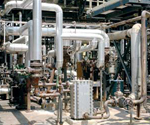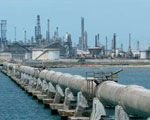The Gela Refinery in Sicily
Located outside Gela in southern part of Sicily, the Gela refinery has been an integral part of the town since 1960 and, over the years, has developed into a leading refinery in the Mediterranean area.
DATE 2023-11-28 AUTHOR Charlotte AnderssonThe Gela Refinery, with a balanced primary refining capacity of 100,000 barrels/day, represents an upstream integrated pole with the production of heavy crude oil obtained from nearby Eni fields offshore Sicily, while downstream it is integrated with Eni’s nearby petrochemical plants. The refinery produces fuels for automotive use and residential heating purposes as well as petrochemical feedstocks.
Besides its primary distillation plants, the Gela refinery contains an FCC reactor with advanced technology, two coking plants for the conversion of low grade feedstock’s and vacuum conversion of heavy residues. All these plants are integrated in order to process heavy residues and manufacture valuable products and produce electricity. The refinery also contains modern residue and exhaust fume treatment plants which allow the complex to comply with the most exacting environmental standards.
Crude oil and oil products are handled on land and by sea. The maritime facilities have a receiving capacity of about 900 ships per year equating to a total of 9 million tonnes of products. For the distribution of products by land, the refinery has 13 platforms to load tank trucks, with a capacity of about 3 500 tonnes/day.
Environmental and social concerns
The advanced engineering structure allows the Gela Refinery to produce high quality finished products such as gasoline with less than 1% benzene content and diesel oils with very low sulphur content. In fact, following a recent survey carried out by the consultant firm Wood McKenzie, the refinery was listed first in Europe for the environmental quality of its products.
 Because the refinery is in operation 24 hours a day, 365 days a year, close supervision and reliability of the equipment are fundamental. Thanks to the integrated work cycle, efficient control of energy consumption and emissions is ensured. “Eni has been engaged for years in the reduction of emissions and energy consumption”, says Massimilano Dell’Agnello, Technology Manager at the Gela Refinery. “Global studies have been carried out on each site using the best available technologies in order to locate where and how to carry out energy and heat recovery.
Because the refinery is in operation 24 hours a day, 365 days a year, close supervision and reliability of the equipment are fundamental. Thanks to the integrated work cycle, efficient control of energy consumption and emissions is ensured. “Eni has been engaged for years in the reduction of emissions and energy consumption”, says Massimilano Dell’Agnello, Technology Manager at the Gela Refinery. “Global studies have been carried out on each site using the best available technologies in order to locate where and how to carry out energy and heat recovery.
The commitments linked with the Kyoto Protocol and the Emission Trading of CO2 that will start officially next January will add further importance to the energy conservation programme of the refinery.
The refinery is the most important industry in an area that is historically difficult from an employment point of view. This adds weight to the social function of the company, which somehow is perceived and actively takes on the role as the economic motor of the Gela territory.
The constant strive to be a good corporate citizen is also reflected in how the Gela Refinery treats its employees who are seen as a precious resource. Safety and environment are top items on the company agenda and are considered key points for the future success of the company. Advanced control systems constantly monitor the production and the facilities whilst training combined with surprise emergency simulation exercises keep the personnel aware that security is essential to the survival of the site.
Future challenges
Maintaining the high technological level of the site and remaining at the forefront regarding innovative technologies are two of the key issues for keep up the competitiveness of the Gela Refinery. “Other main concerns to ensure a prosperous future for the company are to continuously improve site performance, while safeguarding environmental aspects and safety requirements”, Dell’Agnello says.
“One third of the crude oil used by the Gela Refinery is extracted from neighbouring soil. Both the refinery and the Gela community would benefit from an increased integration of the respective activities. This would enhance local esteem and pride and drive the development of the whole region. The aim of the Gela Refinery is naturally to create and maintain a company which produces profit, but it should be a profit which is also valuable for the territory and the people who live here”, he concludes.
Alfa Laval / Gela Refinery cooperation
Today there are some 50 Alfa Laval gasketed heat exchangers installed in the refinery premises in Gela. About one year ago, the refinery also installed a Compabloc heat exchanger in the SWS (Sour Water Stripper) plant.
The SWS unit treats and eliminates the residues (H2S and ammonia) present in the water that has been processed by the various plants in the refinery so the water can then be reintroduced into the cycle. The perfect functioning of the SWS plant is of fundamental importance for the refinery; if it stops, all other units must also be stopped.
“One of the advantages with the Compabloc unit is the absence of gaskets between the plates. This makes it perfect for chemically aggressive environments and for the handling of high temperature and dirty fluids. It also means that it can run for months without the need to be stopped for cleaning, and when maintenance is needed, it is done in half the time compared to a traditional unit”, says Fabrizio Palmeri, Sales Manager Process Industry at Alfa Laval.
The Compabloc unit installed at the Gela Refinery serves as feed/bottom interchanger, i.e. it recovers heat between the bottom and the feed of the stripping column. “Energy saving is a must in Gela Refinery. The Compabloc help us to meet these goals”, he says.
Another Compabloc unit has recently been delivered to the Gela Refinery to be installed in the SWS plant. “The alternatives were traditional shell & tube heat exchangers or welded plate heat exchangers (e.g. Compabloc), says Massimiliano Dell’Agnello, Technology Manager at the Gela Refinery. “We chose Compabloc units since they are very compact and allow us to have two units instead of one, in the same space, so that when maintenance is needed we can switch from one unit to the other without costly production stops.”
Welded heat exchangers also have a higher thermal efficiency and are much easier to clean than shell & tubes. “As coking plants dirty more than many other plants, they need heat exchangers with easy maintenance. A welded heat exchanger, such as Compabloc, is one of the solutions, maybe the best, in line with our high demands”, Dell’Agnello concludes.
The latest news is that the Gela Refinery has placed a significant order with Alfa Laval for six Compabloc units as reboilers for the revamping of the whole SWS plant.

